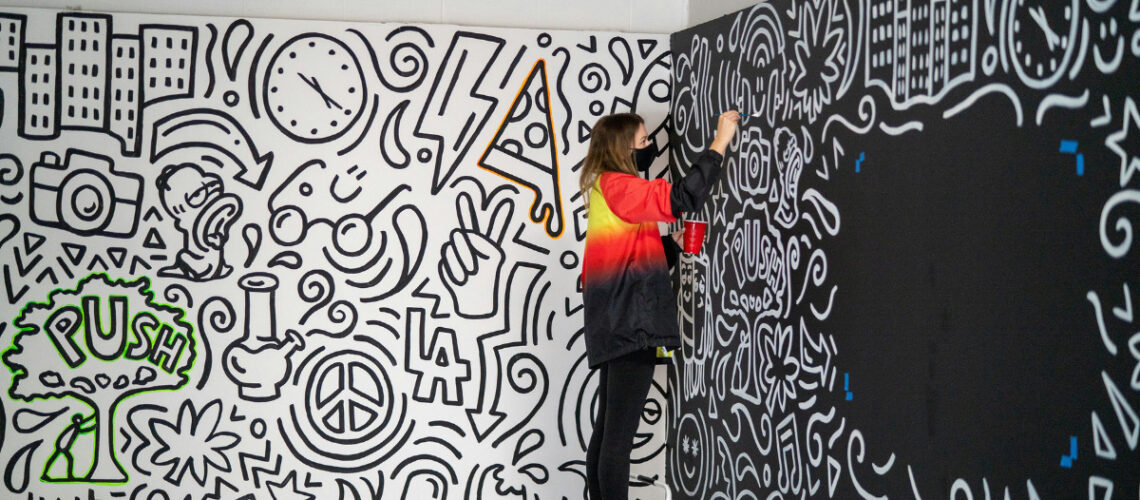Mural painting has long been a captivating form of artistic expression, transforming blank walls into vibrant canvases that tell stories, evoke emotions, and beautify urban landscapes. From bustling city streets to quiet alleyways, murals have the power to captivate viewers and leave a lasting impact on communities. In this article, we’ll delve into the world of mural magic, exploring the techniques and strategies behind creating large-scale paintings and urban art installations that command attention and inspire awe.
The Art of Scale: Thinking Big
One of the defining characteristics of mural painting is its scale – the ability to work on a canvas that spans entire walls or buildings. For artists who have experience with large-scale projects, thinking big is essential to creating impactful murals that dominate their surroundings. Whether it’s a towering skyscraper or a sprawling mural covering multiple storefronts, the scale of the canvas presents both challenges and opportunities for artistic expression.
Planning and Preparation: From Concept to Execution
The journey of creating a large-scale mural begins long before the first brushstroke touches the wall. Scott Biski, known for his meticulous planning and attention to detail, emphasizes the importance of thorough preparation and concept development. This stage involves sketching out ideas, refining compositions, and considering the logistical aspects of the project, such as access to the wall, weather conditions, and safety precautions.
Choosing the Right Tools and Materials
When working on a large-scale mural, having the right tools and materials is crucial to success. Scott Biski recommends using high-quality paints, brushes, and primers designed for outdoor use and durability. For intricate details and fine lines, artists may opt for airbrushes or spray cans, while rollers and large brushes are ideal for covering large areas quickly. Additionally, scaffolding, ladders, and safety equipment are essential for working at heights and ensuring a smooth painting process.
Scaling Designs and Proportions
One of the challenges of large-scale mural painting is maintaining proper proportions and scaling designs to fit the wall seamlessly. Scott Biski employs techniques such as gridding, projecting, or using reference points to ensure accuracy and perspective in his murals. By breaking down the design into manageable sections and working methodically, artists can achieve cohesive and visually striking compositions on a grand scale.
Layering and Depth: Creating Visual Impact
Large-scale murals offer artists the opportunity to play with depth, perspective, and layering to create visual impact and depth. Scott Biski often incorporates elements such as shadows, highlights, and subtle textures to add dimensionality to his murals. This attention to detail not only enhances the realism of the artwork but also engages viewers and invites them to explore the mural up close.
Embracing the Environment: Incorporating Site-Specific Elements
Urban art installations often benefit from incorporating site-specific elements that reflect the surrounding environment and engage with the local community. Scott Biski emphasizes the importance of considering the cultural context, history, and themes relevant to the mural’s location. Whether it’s incorporating architectural elements, paying homage to local icons, or addressing social issues, site-specific murals have the power to resonate deeply with viewers and foster a sense of connection.
Collaboration and Community Engagement
Large-scale mural projects often involve collaboration with communities, businesses, and organizations to ensure a successful outcome. Scott Biski values community engagement and often collaborates with local artists, volunteers, and sponsors to bring his murals to life. From hosting workshops and events to involving residents in the painting process, community collaboration adds layers of meaning and authenticity to large-scale mural projects.
Preserving and Maintaining Murals
Once a mural is completed, efforts must be made to preserve and maintain its integrity over time. It is recommended using protective coatings and sealants to safeguard murals from weather damage, UV exposure, and vandalism. Regular maintenance, such as cleaning and touch-ups, can also help extend the lifespan of murals and ensure they continue to inspire and delight viewers for years to come.
The Artistry of Mural Magic
In conclusion, mural magic is a testament to the artistry, creativity, and ingenuity of artists like Scott Biski who bring large-scale paintings and urban art installations to life. From meticulous planning and preparation to embracing the environment and engaging with communities, mural painting is a collaborative and transformative process that enriches our urban landscapes and inspires us to see the world through a different lens. As we celebrate the magic of murals, let us continue to support and appreciate the artists who use their talents to create beauty, provoke thought, and spark joy in our communities.

